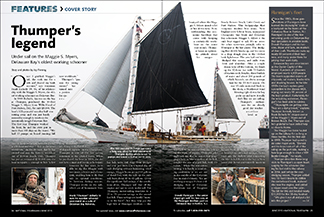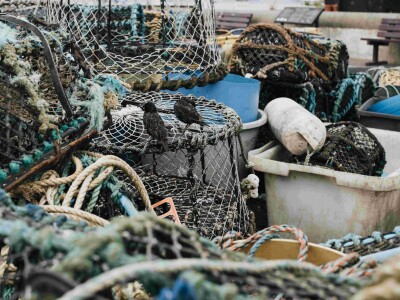Thumper's legend
Under sail on the Maggie S. Myers,
Delaware Bay’s oldest working schooner
Story and photos by Jay Fleming
Once I grabbed Maggie’s tail, she took me for a ride and cleared my bank account,” says waterman Frank Eicherly IV, 56, of his relationship with the Maggie S. Myers, the oldest working schooner on Delaware Bay.
In 1999 Eicherly, known on the bay as Thumper, purchased the 59-foot Maggie S. Myers from Willis Hand of Port Mahon, Del., for only $5,000. The boat’s 122-year-old wooden hull was rotting away and was just barely seaworthy enough to work on the notoriously rough Delaware Bay. The first year Thumper worked the boat, he and his crew put in more than 100 days on the water. “We had 13 pumps on board running full time to keep her afloat, towed a Zodiac as a lifeboat and stayed close to the other workboats.” In the 16 years that he has owned and run the historic workboat out of Bowers Beach, Del., Thumper has put an estimated $250,000 into the boat in repairs — enough to buy “a few new workboats.”
Thumper’s “passion for saving money” has turned into a passion for operating under sail. Along with a handful of skipjack captains on the Chesapeake, Thumper is one of the last sailing watermen in the United States. When he purchased the boat in 1999, she did not have a mast and boom or bowsprit; however he has since been able to rig the Maggie with two masts, a boom and a bowsprit, enabling him to fly four sails in optimal conditions. In between fishing seasons, Thumper works on the sails, which are all homemade from hay bale tarps, cull rings from dredges and crab pot lines.
On a typical day of crab dredging without harnessing wind energy, Maggie burns around 60 gallons of diesel fuel; with the sails up she only will burn about 40 to 45 gallons. Given the significant fuel savings, if the conditions allow, Thumper will shut off the engine and opt to work under sail. For Thumper, motor-sailing translates to a 25 to 33 percent savings in the annual fuel bill. These savings are hardly “money in the bank”, but they help pay the high bills at Flannigan Brothers — the boatyard where the Maggie S. Myers spends a lot of her down time. Notwithstanding the economic hardships that come with keeping a century-old workboat on the water year round, Thumper keeps an optimistic attitude about his unique approach to the seafood business.
While on the topic of repairs, Thumper jokingly tells me that he remembers plugging a hole in “the waterline of the hull, roughly the size of a golf ball, with my t-shirt.” While this was entertaining, it is hardly a comforting confession, as we are out in the middle of the Delaware Bay in mid-February. We are working among a 20-boat crab dredging fleet of Delaware workboats out of Slaughter Beach, Bowers Beach, Little Creek and Port Mahon. This hodgepodge fleet comprises deadrise box sterns, New England-style lobster boats, repurposed Chesapeake buy boats and Delaware Bay schooners.
Maggie S. Myers is the only boat rigged to sail. It’s no wonder other watermen jokingly refer to Thumper as the last pirate. The dredging fleet slowly breaks up, and we move to a deep slough close to the 14-foot bank lighthouse. The area had not been dredged this season, and crabs were fresh and abundant. After a couple dozen licks off the bottom, we finish up the 12-hour day with 33 bushels of mature sook females, three bushels of males and about 200 pounds of whelk bycatch, an above average haul for the 2014-15 season. On our 15-mile motorsail back to the dock, a Northwest wind blowing right down the bay picks up and…








